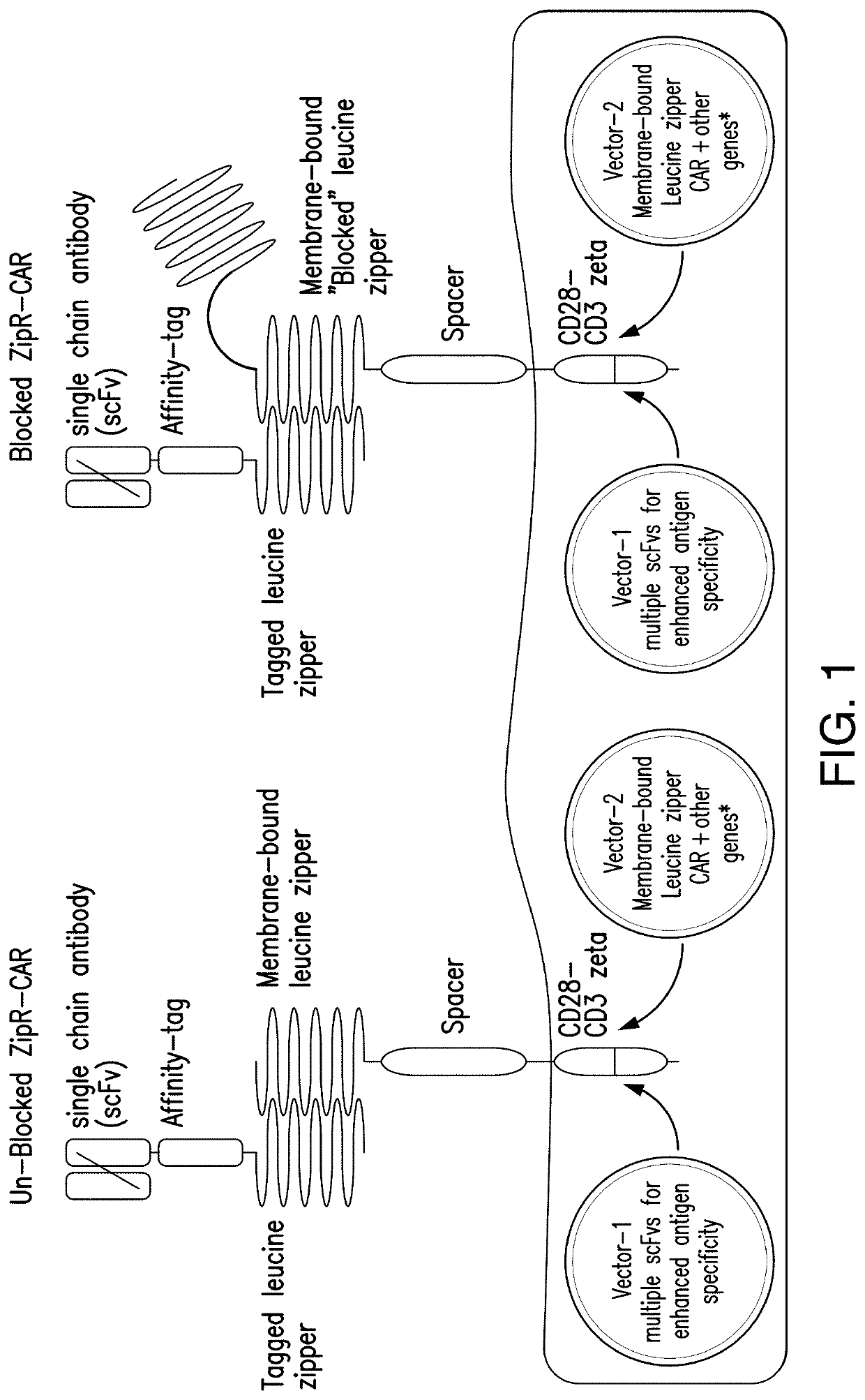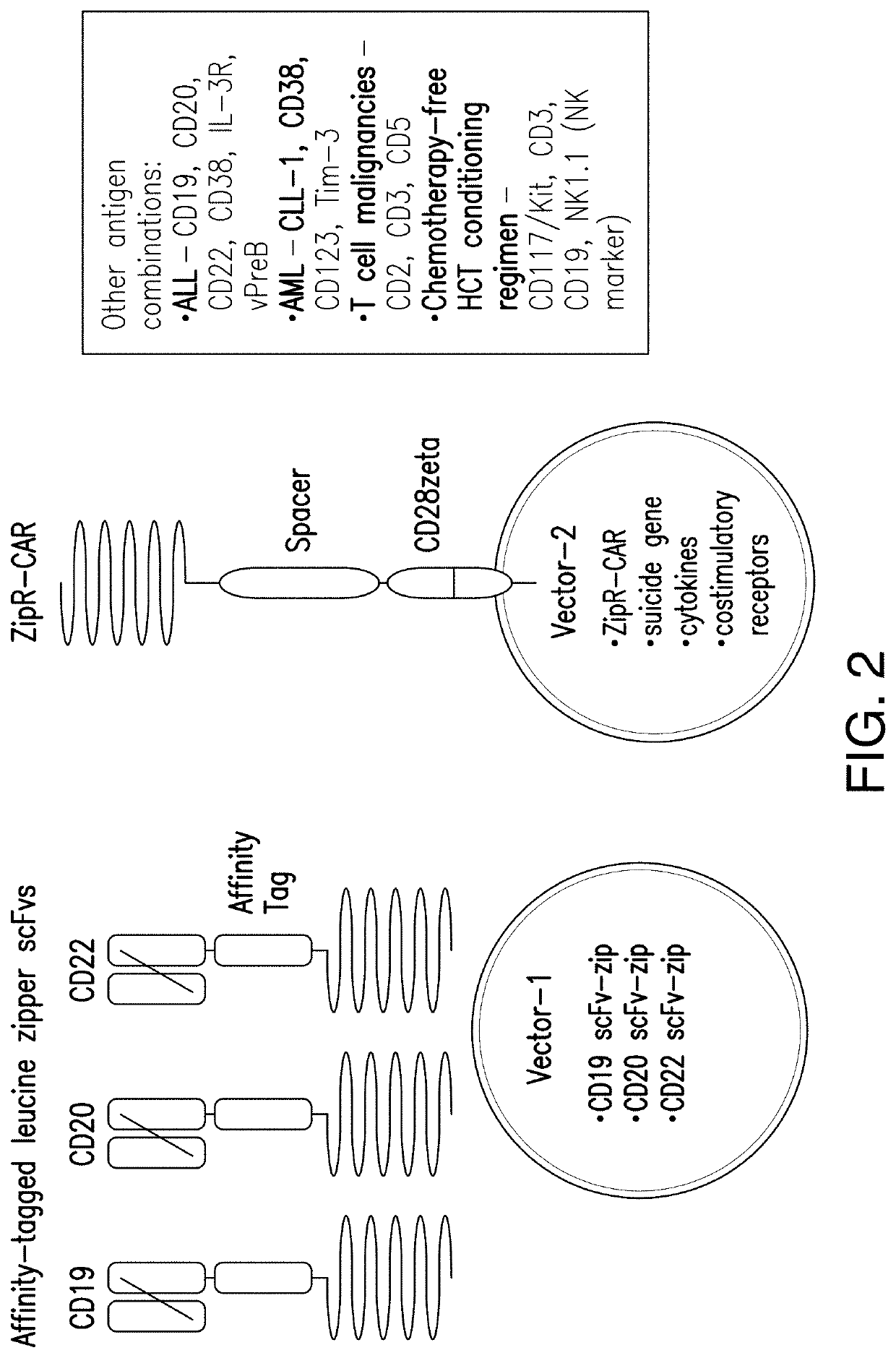Leucine zipper-based compositions and methods of use
- Summary
- Abstract
- Description
- Claims
- Application Information
AI Technical Summary
Benefits of technology
Problems solved by technology
Method used
Image
Examples
example 1
Antigen Receptors with scFv Leucine Zipper Sorting Affinity Tags
[0324]A binary, leucine zipper-based, affinity tag system was developed to allow selective sorting of cells with simultaneous co-transduction with two viral vectors to allow transfer of larger amounts of genetic information without exceeding packaging limits of the viruses. In this system, one viral vector encoded a leucine zipper (e.g., RR12EE345L) with a linked affinity tag (e.g. FLAG, streptag, myc, etc.) (FIG. 1). The second viral vector encoded a membrane-bound leucine zipper (e.g., EE12RR345L) with high predilection to form a heterodimer with the RR12EE345L-affinity tag leucine zipper. When co-transduced into the same target cell, surface capture of the RR12EE345L-affinity tag by the membrane-bound EE12RR345L leucine zipper occurred, allowing surface detection of the affinity tag by flow cytometry and immuno-magnetic selection using magnetic beads conjugated to antibodies specific for the affinity tag.
[0325]A bina...
example 2
ipper-Based Chimeric Costimulatory Receptors (CCRs) Activated by Secreted Immune Checkpoint Blocking scFvs with Conjugated Leucine Zippers and Sorting Affinity Tags
[0329]Chimeric costimulatory receptors (CCRs) comprises scFv and costimulatory domain but lacks a ZAP70-binding motif such as CD3 zeta. CCRs can induce antigen specific costimulation to T cells, while not sending a TCR-like signal and thus not activating T cell killing function. Traditionally, these molecules comprise a single scFv and are limited to a single target antigen. However, they can be designed using a heterodimerizing leucine zipper to bind multiple Zipper-scFvs (FIGS. 10 and 11). As shown in FIG. 10, leucine zipper based CARs and CCRs induce CD3ζ signaling and costimulatory signaling from the same panel of scFvs. T cells can be engineered to express a ZipR-CAR and ZipR-CCR to promote enhanced costimulation in response to the same antigens bound by shared scFv (i.e., both ZipR-CAR and ZipR-CCR use the same leuc...
example 3
ipper-Based Chimeric Costimulatory Receptors (CCRs) Activated by Secreted Cytokines Fusions with Conjugated Leucine Zippers and Sorting Affinity Tags
[0333]T cells can receive cytokine signals via trans-presentation, in which another cell delivers a cytokine to a T cell via surface presentation (e.g., IL-15). Additionally, artificial antigen presenting cells have been engineered that trans-present cytokines such as IL-15 and IL-21 to T cells for in vitro expansion.
[0334]The presently disclosed subject matter provides leucine zippers appended to cytokines, such as IL-3, IL-7, IL-15, IL-18 or IL-21, to provide T cell-delivered cytokine stimulation locally (FIG. 8). As shown in FIG. 8, IL-3 “zipperkine” converted ZipR-CAR into IL-3-based receptor. IL-3 “zipperkine” comprises IL-3 cytokine with C-terminal FLAG-tag and RR12EE345L leucine zipper. The IL-3 zipperkine was captured by the ZipR-CAR and trans-presented onto the surface of the T cell to generate a receptor that can target cells ...
PUM
| Property | Measurement | Unit |
|---|---|---|
| Volume | aaaaa | aaaaa |
| Magnetic field | aaaaa | aaaaa |
| Length | aaaaa | aaaaa |
Abstract
Description
Claims
Application Information
 Login to View More
Login to View More - R&D
- Intellectual Property
- Life Sciences
- Materials
- Tech Scout
- Unparalleled Data Quality
- Higher Quality Content
- 60% Fewer Hallucinations
Browse by: Latest US Patents, China's latest patents, Technical Efficacy Thesaurus, Application Domain, Technology Topic, Popular Technical Reports.
© 2025 PatSnap. All rights reserved.Legal|Privacy policy|Modern Slavery Act Transparency Statement|Sitemap|About US| Contact US: help@patsnap.com



